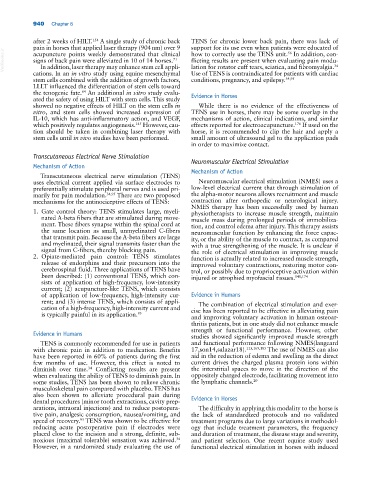Page 974 - Adams and Stashak's Lameness in Horses, 7th Edition
P. 974
940 Chapter 8
after 2 weeks of HILT. A single study of chronic back TENS for chronic lower back pain, there was lack of
154
pain in horses that applied laser therapy (904 nm) over 9 support for its use even when patients were educated of
VetBooks.ir signs of back pain were alleviated in 10 of 14 horses. 71 flicting results are present when evaluating pain modu-
how to correctly use the TENS unit. In addition, con-
acupuncture points weekly demonstrated that clinical
56
In addition, laser therapy may enhance stem cell appli-
lation for rotator cuff tears, sciatica, and fibromyalgia.
34
cations. In an in vitro study using equine mesenchymal Use of TENS is contraindicated for patients with cardiac
stem cells combined with the addition of growth factors, conditions, pregnancy, and epilepsy. 34,95
LLLT influenced the differentiation of stem cells toward
the tenogenic fate. An additional in vitro study evalu-
64
ated the safety of using HILT with stem cells. This study Evidence in Horses
showed no negative effects of HILT on the stem cells in While there is no evidence of the effectiveness of
vitro, and stem cells showed increased expression of TENS use in horses, there may be some overlap in the
IL‐10, which has anti‐inflammatory action, and VEGF, mechanisms of action, clinical indications, and similar
145
which positively regulates angiogenesis. However, cau- effects reported for electroacupuncture. If used on the
176
tion should be taken in combining laser therapy with horse, it is recommended to clip the hair and apply a
stem cells until in vivo studies have been performed. small amount of ultrasound gel to the application pads
in order to maximize contact.
Transcutaneous Electrical Nerve Stimulation
Neuromuscular Electrical Stimulation
Mechanism of Action
Mechanism of Action
Transcutaneous electrical nerve stimulation (TENS)
uses electrical current applied via surface electrodes to Neuromuscular electrical stimulation (NMES) uses a
preferentially stimulate peripheral nerves and is used pri- low‐level electrical current that through stimulation of
marily for pain modulation. 34,95 There are two proposed the alpha‐motor neurons allows recruitment and muscle
mechanisms for the antinociceptive effects of TENS: contraction after orthopedic or neurological injury.
NMES therapy has been successfully used by human
1. Gate control theory: TENS stimulates large, myeli- physiotherapists to increase muscle strength, maintain
nated A‐beta fibers that are stimulated during move- muscle mass during prolonged periods of immobiliza-
ment. These fibers synapse within the spinal cord at tion, and control edema after injury. This therapy assists
the same location as small, unmyelinated C‐fibers neuromuscular function by enhancing the force capac-
that transmit pain. Because the A‐beta fibers are large ity, or the ability of the muscle to contract, as compared
and myelinated, their signal transmits faster than the with a true strengthening of the muscle. It is unclear if
signal from C‐fibers, thereby blocking pain. the role of electrical stimulation in improving muscle
2. Opiate‐mediated pain control: TENS stimulates function is actually related to increased muscle strength,
release of endorphins and their precursors into the improved voluntary contractions, restoring motor con-
cerebrospinal fluid. Three applications of TENS have trol, or possibly due to proprioceptive activation within
been described: (1) conventional TENS, which con- injured or atrophied myofascial tissues. 140,174
sists of application of high‐frequency, low‐intensity
current; (2) acupuncture‐like TENS, which consists
of application of low‐frequency, high‐intensity cur- Evidence in Humans
rent; and (3) intense TENS, which consists of appli- The combination of electrical stimulation and exer-
cation of a high‐frequency, high‐intensity current and cise has been reported to be effective in alleviating pain
is typically painful in its application. 95 and improving voluntary activation in human osteoar-
thritis patients, but in one study did not enhance muscle
strength or functional performance. However, other
Evidence in Humans studies showed significantly improved muscle strength
TENS is commonly recommended for use in patients and functional performance following NMES(langeard
with chronic pain in addition to medication. Benefits 17,son14,salazar18). 113,169,185 The use of NMES can also
have been reported in 60% of patients during the first aid in the reduction of edema and swelling as the direct
few months of use. However, this effect is noted to current drives the charged plasma protein ions within
34
diminish over time. Conflicting results are present the interstitial spaces to move in the direction of the
when evaluating the ability of TENS to diminish pain. In oppositely charged electrode, facilitating movement into
some studies, TENS has been shown to relieve chronic the lymphatic channels. 20
musculoskeletal pain compared with placebo. TENS has
also been shown to alleviate procedural pain during
dental procedures (minor tooth extractions, cavity prep- Evidence in Horses
arations, intraoral injections) and to reduce postopera- The difficulty in applying this modality to the horse is
tive pain, analgesic consumption, nausea/vomiting, and the lack of standardized protocols and no validated
speed of recovery. TENS was shown to be effective for treatment programs due to large variations in methodol-
95
reducing acute postoperative pain if electrodes were ogy that include treatment parameters, the frequency
placed close to the incision and a strong, definite, sub‐ and duration of treatment, the disease stage and severity,
noxious (maximal tolerable) sensation was achieved. and patient selection. One recent equine study used
34
However, in a randomized study evaluating the use of functional electrical stimulation in horses with induced

